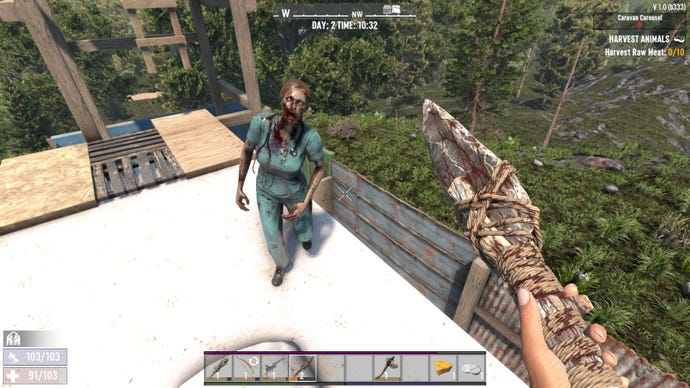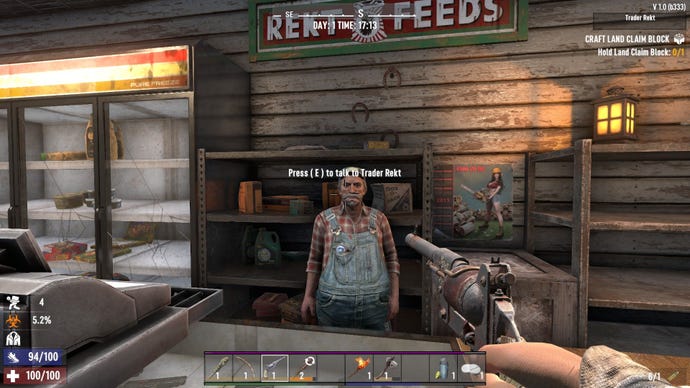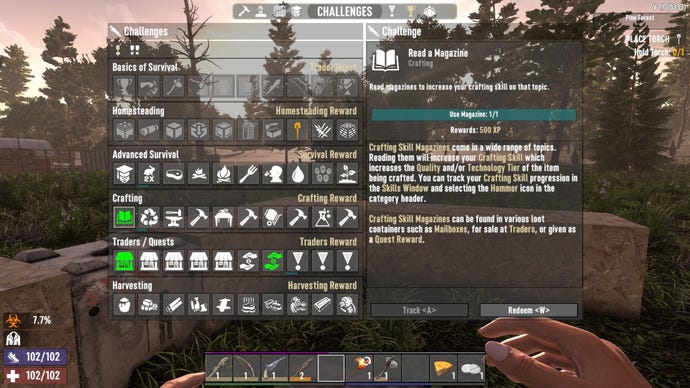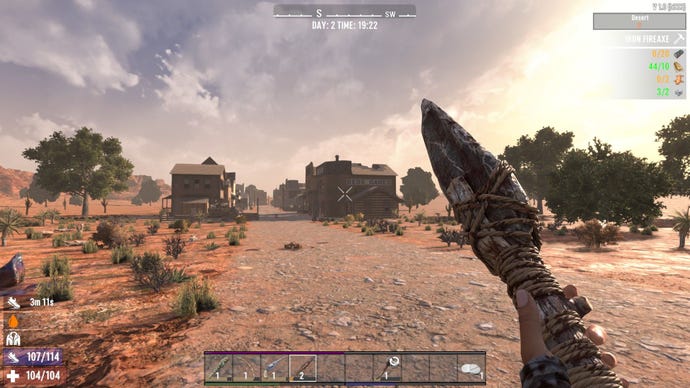Products You May Like
You’re a long time undead. 7 Days To Die was shuffling along in early access for 11 years, until version 1.0 finally burst through the windows. In that time, many other survival games have sprouted, blossomed, and gently faded away. I first visited the burnt-out ruins of this zombie-infested world a decade ago and I returned to it this week to find a tree-puncher that, despite bearing the pockmarks of early access, retains much of what made it enjoyable back when the survival genre was still wearing its baby onesie. Instead of a review, I figured I’d scribble together a mini starter guide for new (or returning) players. Partly because the game is a proper time sink and it was taking me so long to get through everything. But mostly because I wanted to use that numberful headline. So, here you go: 7 dos and 7 don’ts in 7 Days To (7) Die.
Don’t expect a revolution in survival game tropes
If you’ve been gaming at all in the past decade, you know how this is going to go. Hunger meters, angry mobs, inexplicable crafting logic – it’s all there, partly because this game was among the first to embrace the traditions of the genre. Yes, a lot has been added to the zombiethon during its lifetime (graphical overhauls, skill trees, moddable weapons, trading outposts) but the moment-to-moment scavenging feels the same, and the heart of the game has not truly changed. That said, it’s a stout heart…
Do embrace the nomad’s life
The core fantasy is intact. You’re here to find a home, fortify it against bitey bois, survive there for as long as you can, then inevitably lose everything to a nightmarish horde before abandoning it and moving on to the next place. 7 Days makes zombies into a form of weather, translating the post-disaster itinerancy of TV shows like The Walking Dead (from camp to farm to prison to town) into something you can play alone or with buddies. None of that is new to the game, like I say. It had the exact same appeal in 2013. But you know what? It felt good back then to travel the roads, searching for a new place to rest your bones, and it feels even better today, for reasons I’ll go into shortly.

Don’t worry about death
When you croak it, you’re given the options to respawn either back at the last place you camped, or near your place of death. By default a death means losing some XP (used to invest in skills) but there’s a point at which even this bottoms out, and the penalty won’t apply. In some cases (depending on difficulty) death can be weirdly helpful, as it can completely clear whatever status ailments you have. It’s basically Minecraft rules, immortality with a little wrist slap. So unless you’re playing in permadeath mode, let go of your fear and get dangerous.
Do worry about water
And food too. Not because thirst and hunger will lead to the mild annoyance of death, but because these health conditions cause your stamina to regenerate at a slower rate. That means you get tired much quicker when stabbing zombos. This is plain annoying. Most of my deaths could have been avoided if I’d been fully watered when a crowd of rotfolk decided to descend upon me. Nothing hurts more than your pride when you’re too knackered and thirsty to even swing a baseball bat.

Don’t bust it down to easy too quickly
There is a tension in every survival game. The creative home-builder in you wants to faff around with the crafting systems and make yourself a grand hideout. Meanwhile, the game world wants to poke and prod at you with obstacles, and leave you slowly bleeding out. In 7 Days, that obstacle is not just hunger or infection but the constant random spawning of classic Romero corpsedorks. They do not want you to do stuff. A gnawing possibility arises: why not bust it down to the easiest preset difficulty setting? They will die faster, move slower, and you can build more, uninterrupted. Wait! Not yet. The tension is by design. Removing some frictional zombie teeth will make it seem the game is “respecting” your time (as I’ve mentioned it’s a real clock sucker). But if you do make it easier, know that some of that important tension will drain away in return. Which brings us to the next point.
Do play around with the difficulty options
7 Days is surprisingly generous when it comes to building out your own custom difficulty. You can double the rate at which you earn XP, for example, but crank up the speed of zombies. You can demand an airdrop of supplies every day and triple the amount of damage you do to building blocks, but then increase the damage zombies do to your fort’s walls as well. In some ways this many options can be overwhelming. You can always just go with a preset difficulty. But I found playing around has let me make a world that jabs at me in juuust the right ways. Everyone has a microscopically different expectation of what “difficulty” means in a survival game, with all its contracting meters and bodily hazards. (The human metabolism isn’t consistent from person to person in real life, why would an abstraction of our endless burger desire be universally accepted?) So go crazy. Fiddle with the options until you find some balance between harm and helpfulness that works for you.

Don’t hang out with traders
Traders were added to the game a few years after it initially appeared, and they’ve grown from simple salespeople into ravenous quest givers with large settlements all their own. Unfortunately, these freakishly resourceful folks completely eradicate the sensation of being alone against the odds in the wasteland. I shot the first trader I met in the head with a hastily crafted pistol, only to learn they are also invulnerable. They are holed up in their fortresses, overstocked with every good imaginable, yet eminently unrobbable. In a post-apocalyptic zombie game, it not only feels weird that such people exist, but equally bizarre that you cannot simply commit acts of grand banditry against them. My advice? After the tutorial, ignore them as much as possible. Snub these invincible jerks. Or, even better, mod them out of the game completely!
Do shop around for a good location
There’s a saying in chess: “look for a good move, then find a better one”. This too applies to moving home in 7 Days. It is like any good property development TV show. Find a battered fixer-upper with tons of potential, and make it your own. Ah, a farmhouse with an adjacent barn. Wouldn’t this look lovely with a moat, darling? Oh look, a cosy camp of caravans in the hills. Wouldn’t this be wonderful if we surrounded it with artisanal spikes and land mines? The only caveat, of course, is that your beautiful new home will then attract plenty of, ahem, “prospective buyers” who will destroy everything in sight. At which point, you move onto the next place. It’s a strange property ladder, yes. But one that is bursting with newly added building types since the game’s earliest days. Movie theatres, hotels, military outposts, high schools… Explore early and often to find the best place to settle down (easily defensible, close to a water source, unobstructed views of the surrounding landscape). Take your time. Here, home ownership is eminently achievable, with enough violence.

Don’t forget the blood moon
Game’s called 7 Days To Die for a reason. Every week a big horde will sweep through your locale on the night of a blood moon (you can also change this to every 14 days in the difficulty settings). The swarm is constant, a bumbling mass of decaying jackasses from dusk ’til dawn. Mostly, this is solved by stockpiling as much ammunition as possible, and building barricades that will give you the time to potshot every groaning cadaver with patient resolve. But reaching this level of preparedness isn’t easy. Which makes my next point a pill you’ll have to swallow.
Do follow the tutorial challenges
I know nobody wants to go to school during the apocalypse. But eleven years of early access have left a mark on the game’s tutorialising, which is a hodgepodge of UI text splashed in menus, alongside (genuinely useful) tooltips to read as your world loads. It’s not overly cohesive. But! The challenges tab gives you bite-sized crafting quests that will give you an idea of the web of items on offer. It’s a crafting game, after all, and that means even seemingly simple things demand a spaghetti of prerequisites. If you don’t want to learn another survival game’s opaque logic (bones make glue and glue makes duct tape) then I don’t know what you’re doing here. But if you’re determined to adapt to your cozy, zombie-spearing life, the tutorial challenges provide a curriculum that will improve your odds.

Don’t be afraid of a little dysentery
Unless you’re playing on some hardcore modes, the dangers of drinking “murky water” are not so bad. Every uncooked item and slurp of unboiled water carries with it a percentage chance to give you gut problems. And if you do get a case of the ol’ speedshits, it will be clearly denoted on-screen by a small symbol of a sad bum doing a poo. Wonderful. But you should know that ordinary thirst is a worse enemy. In other words, sip freely from the pool of water in that zombie-infested bathhouse. It’s the only source of hydration for miles around. Drink up, and ignore the gagging sound effects of your character as they struggle to keep it down. They’re fine.
Do watch out for traps
Despite being a game offering procedurally generated worlds, the developers have created many locations as pre-built “points of interest”. A nice surprise is that each farm, hardware store, apartment block, and hospital can have its jump scares and secrets, the designers revealing an enjoyment for undead pranks. There are monster closet moments, often literally, as zombies hide in wardrobes and toilet cubicles only to burst out while you’re rummaging through kitchen cabinets for canned food. There are floors that collapse from underneath you and snakes lurking in the garden grass. Not only that, but many places have hints of bespoke environmental storytelling. Half-dug graves, boarded up windows, a lonely noose hanging from the rafters. I didn’t expect touches like these in a rando-gen survival game, and they go a long way to building the atmosphere.

Don’t take mercy on a coyote thinking that, because it ran away after being clubbed once, it is only a sort of “misunderstood puppy” and not, in fact, an obnoxious little terrorist who will chew on your ankles in the middle of a tense fight with some zombies, getting you killed in the process, the wee bastard
These dogs do not deserve to go to heaven. There, I said it.
Do go looking for antibiotics if you’re infected
Not because you necessarily need them (at least, I didn’t – the quickest way for me to lose this status was to simply die and respawn). But because it all adds to the fantasy. 7 Days is at its best when you fully step into the role of a put-upon wasteland loser. This means making your own goals on the hoof, and what better way to start a classic zombie story than “I got infected and went looking for pills”. This applies to all the needs and wants of the game. The challenges will teach you how to play and give you a checklist of stuff to try. But in the end you will get more out of the survivalist rambler once you start carving your own path. Build a fort on a lake and panic when you discover zombies can swim. Spot a desert and decide to cross it in search of a new biome. Pump all your resources into a machine gun and save it for the ceaseless horde of the blood moon (then gulp with embarassment when you run out of ammo in the first 60 seconds of shooting). Past all the early access stretchmarks, 7 Days remains a game about finding freedom in a pressure cooker. Turn the heat up, and enjoy it.
